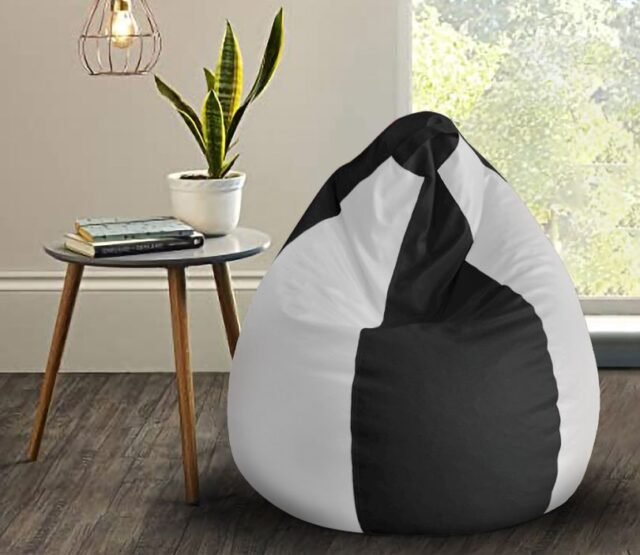Bean bags are more than just casual seating; they’re comfort havens, style statements, and a functional addition to modern interiors. But the fabric of a bean bag plays a key role in determining not just its aesthetics, but its comfort, durability, maintenance, and overall usability. Whether you’re shopping for a chic living room accent, a cozy reading nook, or durable seating for kids and pets, understanding the differences between bean bag fabrics is crucial.
In this article, we’ll dive deep into the most popular bean bag materials and compare them based on comfort, durability, ease of cleaning, breathability, price, and aesthetic appeal. By the end, you’ll be equipped to choose the perfect fabric for your needs.
1. Cotton Bean Bags
Overview:
Cotton is a natural fabric that’s soft, breathable, and lightweight. It’s often used in casual-style bean bags for indoor use.
Pros:
- Extremely soft and comfortable
- Breathable and cool for warm climates
- Eco-friendly and non-toxic
- Great for kids and sensitive skin
Cons:
- Stains easily
- Can shrink or wrinkle after washing
- Not water-resistant
- Requires frequent cleaning
Best For: Bedrooms, casual lounging, and homes with children who need gentle fabrics.
Verdict: Cotton is ideal if comfort and skin-friendliness are your top priorities, though you’ll need to be prepared for higher maintenance.
2. Leather and Faux Leather Bean Bags
Overview:
Leather and its synthetic counterpart (PU leather or faux leather) offer a sleek, modern look. They’re frequently chosen for office spaces, formal living areas, and media rooms.
Pros:
- Stylish and elegant appearance
- Easy to wipe clean
- Water and stain resistant
- Durable if maintained properly
Cons:
- Can get hot and sticky in warm weather
- Not very breathable
- Real leather is expensive
- Prone to cracks over time (especially faux leather)
Best For: Professional or contemporary spaces, adults, and those wanting easy-clean options.
Verdict: A great pick for aesthetics and easy cleaning, but may lack the softness and breathability of fabric materials.
3. Polyester Bean Bags
Overview:
Polyester is a synthetic fabric commonly used in bean bags for both indoor and outdoor use. It’s often treated with coatings to enhance durability and water resistance.
Pros:
- Lightweight and durable
- Water-resistant when coated
- Comes in vibrant colors and prints
- Affordable
Cons:
- Less breathable than cotton
- Can feel plasticky if not high quality
- May fade in direct sunlight
Best For: Outdoor seating, playrooms, and budget-friendly options.
Verdict: Polyester strikes a good balance between durability and affordability, making it suitable for high-traffic or outdoor environments.
4. Velvet and Suede Bean Bags
Overview:
Velvet and suede offer a plush, luxurious texture that elevates the overall feel of a bean bag. They’re typically used in premium home décor settings.
Pros:
- Luxuriously soft and rich in texture
- Looks elegant and upscale
- Comfortable and cozy, especially in cold weather
Cons:
- Attracts dust and pet hair
- Can be difficult to clean
- Not water- or stain-resistant
- Requires gentle care
Best For: Formal living rooms, cozy corners, and aesthetics-focused interiors.
Verdict: Perfect if you’re going for a luxe look and don’t mind a little maintenance to preserve its rich texture.
5. Nylon Bean Bags
Overview:
Nylon is a tough, synthetic fabric that’s widely used in outdoor furniture and sports equipment. Bean bags made from nylon are built for durability and exposure to the elements.
Pros:
- Highly durable and strong
- Water-resistant and quick-drying
- Easy to clean and wipe
- Suitable for outdoor use
Cons:
- Less soft and more rigid feel
- Not breathable
- Can get hot in sunlight
- Limited design appeal
Best For: Outdoor patios, poolside seating, kids’ rooms, and heavy-duty usage.
Verdict: Ideal for rough use and outdoor settings, nylon offers strength and practicality over plush comfort.
6. Corduroy Bean Bags
Overview:
Corduroy is a soft, ridged fabric known for its cozy texture and retro charm. It’s warm, durable, and provides a comforting seating experience.
Pros:
- Soft yet durable
- Warm and cozy texture
- Stylish in a vintage or rustic setting
- Moderate maintenance
Cons:
- Can collect lint and pet hair
- Stains need prompt attention
- Limited color variety
Best For: Living rooms, dens, and chill-out zones where comfort meets character.
Verdict: Corduroy offers both personality and comfort, making it a unique but practical choice.
7. Chenille Bean Bags
Overview:
Chenille is a tufted fabric that’s soft, plush, and very comfortable to the touch. It gives bean bags a cozy, welcoming feel.
Pros:
- Super soft and plush
- Warm, comfortable texture
- Great for indoor lounging
- Rich colors and subtle sheen
Cons:
- Can snag easily
- Difficult to clean spills and stains
- Not suitable for pets or rough use
Best For: Bedrooms, reading nooks, and cozy corners.
Verdict: Chenille is all about comfort and indoor luxury. Not ideal for high-traffic areas or outdoor settings.
Factors to Consider When Choosing Bean Bag Fabric
When picking a bean bag, it’s important to go beyond just aesthetics. Here’s what to factor in:
- Location of Use: Indoor bean bags can use softer, more delicate fabrics. Outdoor ones require water and UV resistance.
- Users: Kids and pets require easy-clean, durable fabrics. Adults may prefer stylish and luxurious materials.
- Climate: Breathable fabrics like cotton are better for warm climates, while plush fabrics like velvet suit colder regions.
- Maintenance: If you want low-effort cleaning, opt for leather, faux leather, or polyester.
Final Thoughts: Which Material Works Best?
There’s no one-size-fits-all answer—the best bean bag fabric depends on your personal needs and preferences:
- For luxury and aesthetics: Go with velvet or suede.
- For durability and outdoor use: Choose nylon or polyester.
- For softness and eco-friendliness: Opt for cotton or corduroy.
- For easy maintenance: Faux leather or polyester is your best bet.
A well-chosen fabric can enhance not just your comfort, but the longevity and appeal of your bean bag. Always consider your lifestyle, the placement area, and how much maintenance you’re willing to invest.
If you’re looking for high-quality bean bags in a variety of fabric options—from plush cotton to chic faux leather—explore the diverse collection at Wooden Street, where comfort meets craftsmanship.







